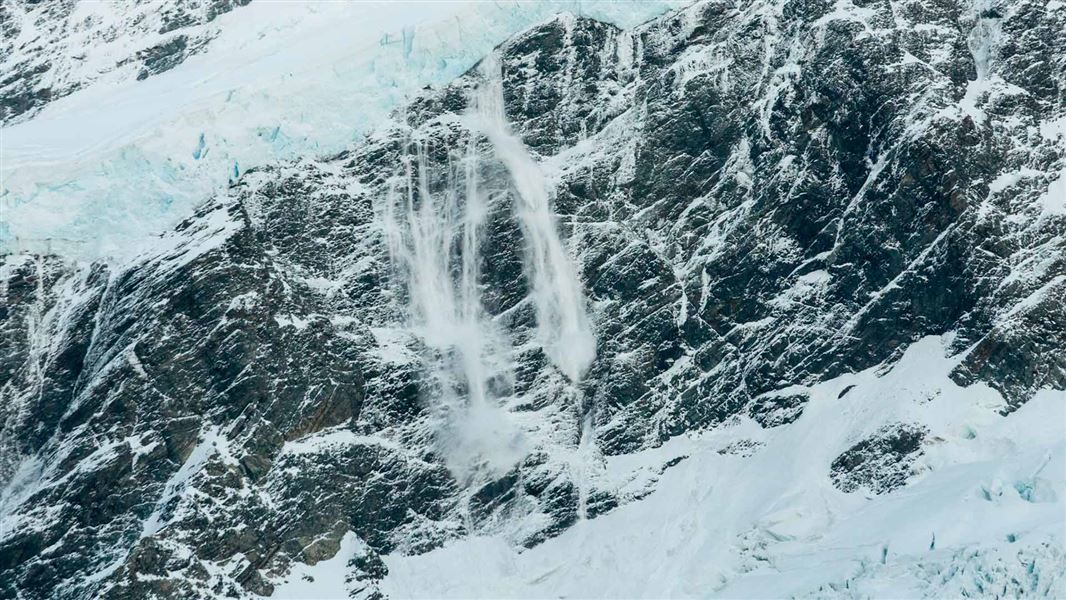There are two tools to help you assess avalanche danger:
- New Zealand Avalanche Advisory (NZAA) - based on the stability of snow and changes with the weather.
- Avalanche Terrain Exposure scale system (ATES) - based on terrain and does not change with the weather.
Anytime that snow and steep slopes are combined there is potential for an avalanche.
New Zealand Avalanche Advisory (NZAA)
The best way to understand the avalanche danger in Aoraki/Mount Cook National Park is to check the New Zealand Avalanche Advisory (NZAA). The NZAA provides daily assessments of avalanche likelihood at different elevation bands and aspects, primary and secondary dangers, along with recent avalanche activity, current snowpack conditions and mountain weather. The NZAA is also available at DOC visitor centres.
The NZAA is provided by the Mountain Safety Council (MSC) as an advisory only. We recommend you also check the Aoraki/Mount Cook National Park weather forecast as part of your trip planning.
Avalanche Terrain Exposure Scale (ATES)
The Avalanche Terrain Exposure Scale (ATES) rates avalanche terrain based on the angle and shape of the ground or the number of established avalanche paths.
How ATES applies in Aoraki/Mount Cook National Park
The majority of the park and surrounding terrain is serious avalanche country. The majority of the park is complex avalanche terrain, which demands respect from all who use it. There is very little simple terrain and a moderate amount of challenging terrain.
Hooker Valley Track
You should not go beyond the outlet end of the lake unless you have the right avalanche experience.
Ball Hut Road
Large avalanches regularly cross the road each winter and into the spring. You should not stop in any of the marked avalanche paths. Check with the visitor centre for the latest avalanche information prior to walking or four-wheel driving here.
Mueller Hut Route
The route to Mueller Hut travels through complex avalanche terrain. There is no way to avoid being exposed to avalanche danger on this route when there is enough snow in the start zones to produce avalanches. Check at the visitor centre to see if avalanches are likely to be an issue.
If you lack experience at travelling in avalanche terrain, our recommendation is that you should only go up or down from the hut when the avalanche danger is low.
If staying overnight in the hut, you need to be prepared to stay longer if the danger level rises while you are there.
ATES ratings for other areas
You need to have the right level of experience to safely travel simple, challenging or complex terrain. To find out what experience is needed for each, check our avalanche safety page.
Simple
- Braemar Dome
- Godley Valley floor
- Hooker Valley track to Hooker Lake
- Kea Point track
- Lower Murchison Valley
- Red Tarns track
- Tasman Valley floor to start of white ice
- Tasman Valley road to Blue Lakes
- Village tracks
Challenging
- Annette Plateau
- East Hooker route
- Fox Glacier
- Franz Josef Glacier
- Liebig Range – western side
- Mount Cook Range
- Mueller Glacier
- Sebastapol
- Sladden Glacier
- Upper Tasman Glacier from white ice
Complex
- Ball Glacier and Caroline Face
- Ball Hut road
- Ball Pass
- Beetham Valley
- Bonney Glacier
- Cinerama Col route to Grand Plateau
- Classen Glacier
- Copland Pass
- Fitzgerald and Separation Streams
- Fritz Range
- Godley Glacier
- Gorilla Stream
- Grand Plateau
- Grey Glacier
- Haast Ridge and Freshfield Glacier
- Hooker Hut
- Hooker Valley from Gardner icefall onwards
- Main Divide
- Mueller Hut to Annette Plateau
- Malte Brun Range
- Murchison headwall
- Route from Centennial Hut to Almer Hut
- Route from Pioneer Hut to Chancellor Hut
- Sealy Range – eastern side
- Sealy Tarns to Mueller Hut
- Sealy Tarns Track
- Upper Murchison Glacier
- Valleys on the eastern side of Ben Ohau Range
- Western shore of Hooker Lake
Avalanche season
At higher altitudes avalanches can occur at any time of the year as snow falls year-round in the park. Climbers can be at particular risk during the summer at higher elevations.
During winter and spring, avalanches can occur on some park tracks, and on the Ball Hut road.
Be avalanche aware!
If you are going into places avalanches could occur, make sure you:
- have checked the ATES class for where you want to go and the NZAA for the avalanche rating
- have the skills for the ATES class you are going into
- take an avalanche transceiver, a snow shovel and a probe. Know how to use these tools!
Download brochure
Be avalanche alert - avalanche terrain ratings: Aoraki/Mount Cook National Park brochure (PDF, 30K)
